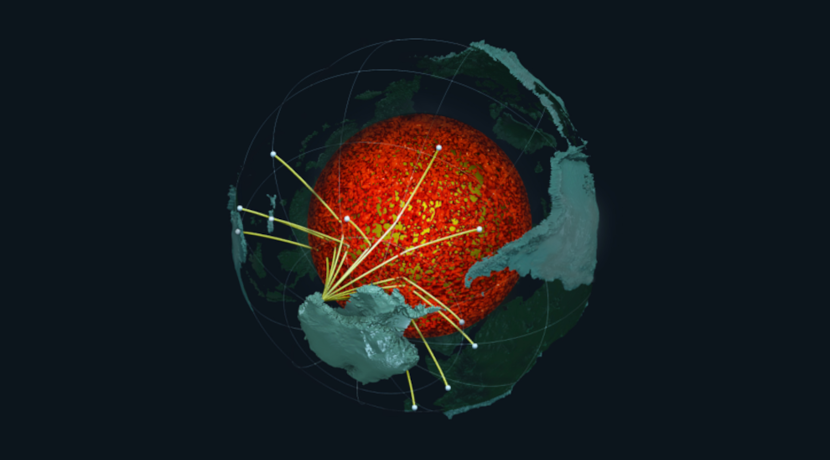Earthquake notes appear
Robert Klatt
earthquake waves illustration
)amabalA for ytisrevinU ehTytisrevinU etatS anozirA ta iL gnimgniM dna orenraG drawdE .srDnellewnebdrE red noitartsullI(Photo: ©
- It is located in the heart of the Earth Very slow speed zones (ULVZ)Seismic waves caused by earthquakes move very slowly
- the ULVZ materials were previously unknown
- The new measurement data now shows that the The ULVZ probably formed from the ancient ocean floorthat sank into the ground
Ultra slow velocity zones (ULVZ) are located in the Earth’s core, where seismic waves from earthquakes travel very slowly. New measurement data shows that these layers likely consist of ancient ocean floors that sunk deep into the Earth’s interior.
Tuscaloosa (USA). For the most part, geosciences can only explore the Earth’s interior indirectly, for example through seismic observations, because so far the wells have reached a maximum depth of only twelve kilometers. Seismic waves, which propagate and reflect within the Earth, are mainly used for this purpose. Since the speed of earthquake waves varies greatly from one region to another, refraction effects similar to the refraction of light occur on water surfaces.
The contrast between the Earth’s layers is sometimes intense. The density gradient between Earth’s mantle and core far exceeds that of air and rock. Many complex phenomena are evident in these regions in particular. However, not every detail of the Earth’s internal structure can be directly understood by examining seismic waves. An increasing number of measurement points and more comprehensive data allow for ever more accurate assessments of complex reflection patterns. This recently led to the discovery of a 650-kilometer-wide metal ball deep in the Earth’s interior.
Ultraslow velocity regions in the Earth’s interior
About three decades ago, scientists discovered the most bizarre underground formations to date, which immediately sparked research interest. There are structures between the liquid core and viscous mantle in which seismic waves propagate remarkably slowly. These are called Ultra Low Velocity Zones (ULVZ). Despite its relatively small thickness of only five to 50 kilometers, it is denser than the upper mantle and does not extend globally, but forms distinct regions.
There have been various assumptions about its formation. One widely used model assumes a partially molten material due to thermal anomalies caused by processes at the core-mantle interface. However, some ULVZs are far from the hottest regions in this boundary layer, indicating that other, uncharacterized material in the region may be involved.
New advertisement for ULVZ
New study by University of Alabama He has now come to the conclusion that the ULVZ may have formed from ancient ocean floors that had sunk into the Earth’s interior. According to what was published in the specialized magazine Science advances The researchers analyzed data from a network of 15 measuring stations in Antarctica. In total, more than 1,000 seismic observations were recorded over a three-year period, according to Samantha Hansen.
“Seismic surveys like ours provide the highest resolution imaging of our planet’s internal structure, and we are finding that this structure is much more complex than previously thought.”
Earthquake waves echo from the Earth’s core
As Edward Garnero explains, the reflections of seismic waves from the Earth’s core were the focus of the study. This made it possible for the first time to create a very accurate representation of the boundary layer between Earth’s core and mantle in the Southern Hemisphere.
“In analyzing thousands of seismic records from Antarctica, our high-resolution imaging method found thin, anomalous regions of material in the cosmic background radiation everywhere we looked.”
According to the authors, the most plausible explanation for the nature of the detected areas is the materials that once made up the sea floor and were infiltrating very slowly along plate boundaries in tectonic subduction zones. Due to their variable thickness, scientists envision these areas as mountainous formations in the Earth’s interior.
The thickness of the material ranges from a few kilometers to several tens of kilometres. This indicates that in the core we see mountains as high as five times the height of Mount Everest in some places.”
Science Advances, doi: 10.1126/sciadv.add4838

“Social media evangelist. Baconaholic. Devoted reader. Twitter scholar. Avid coffee trailblazer.”







More Stories
These brands are most vulnerable to phishing scams
Apple Maps Now Has a Web Version and Wants to Challenge Google Maps
Best AirDrop Alternatives for Android